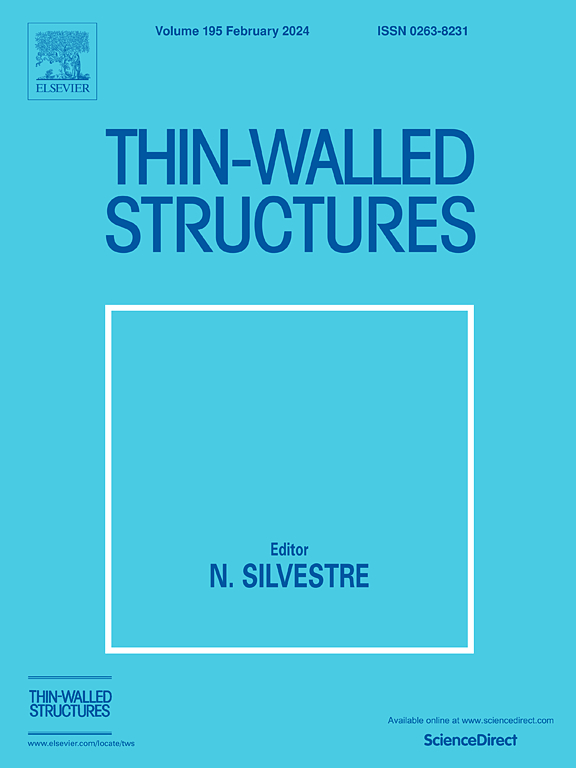功能分级三周期最小表面元结构的动态压缩行为
IF 5.7
1区 工程技术
Q1 ENGINEERING, CIVIL
引用次数: 0
摘要
三重周期性最小表面(TPMS)晶格结构因其重量轻、强度高和出色的能量吸收能力而备受关注。然而,由于之前的研究主要集中在相对密度、尺寸及其准静态力学性能上,因此还没有充分了解可控制 TPMS 拓扑形态的振幅对 TPMS 结构动态性能的影响。本研究提出了三种不同振幅的均匀片基 TPMS 结构和三种功能分级片基 TPMS 结构。在准静态和动态加载条件下进行了实验和数值模拟。通过粉末床熔融技术制造了六种由 316 L 不锈钢制成的 TPMS 晶格结构。在应变率为 0.001 s-¹ 的条件下进行了准静态压缩试验。实验结果表明,增加振幅可以提高结构的弹性模量、高原应力和能量吸收能力。此外,功能梯度振幅结构具有更高的能量吸收能力,与振幅为 1 的均匀结构相比,采用线梯度和对数梯度策略的结构分别提高了 17.38 % 和 35.43 %。采用有限元法(FEM)构建了动态压缩数值模型,并通过应变速率为 695 s-¹ 的分体式霍普金森压力棒(SHPB)试验验证了模型的有效性。系统研究了动态压缩下结构的力学响应、变形模式和应力增强效应。结果表明,动态冲击荷载下结构的机械性能和能量吸收能力随着应变速率的增加而提高。从准静态模式过渡到冲击模式的临界速度随振幅的增加而增加。在应变速率低于 6000 s-¹ 时,应变速率效应是影响动态应力增强的主要因素。随着应变速率的不断增加,动态应力增强是惯性和应变速率共同作用的结果,惯性效应逐渐成为主导因素。这项研究表明,功能梯度 TPMS 元结构在准静态压缩和动态压缩条件下具有优异的机械和能量吸收性能,有望应用于被动安全保护领域。本文章由计算机程序翻译,如有差异,请以英文原文为准。
Dynamic compressive behavior of functionally graded triply periodic minimal surface meta-structures
Triply periodic minimal surface (TPMS) lattice structures have gained considerable attention because of their light weight, high strength, and excellent energy absorption capabilities. However, the effect of the amplitude that can control the topological morphology of a TPMS on the dynamic properties of the TPMS structure is not yet fully understood, as previous studies have focused on the relative density and size as well as their quasi-static mechanical properties. In this study, three types of uniform sheet-based TPMS structures with different amplitudes and three types of functionally graded sheet-based TPMS structures were proposed. Experiments and numerical simulations were conducted under quasi-static and dynamic loading conditions. Six types of TPMS lattice structures made of 316 L stainless steel were manufactured via powder bed fusion. Quasi-static compression tests were performed at a strain rate of 0.001 s⁻¹. The experimental results indicate that increasing the amplitude can increase the elastic modulus, plateau stress, and energy absorption capacity of a structure. Moreover, the functional gradient amplitude structure has a higher energy absorption capacity, and the structures with line and log gradient strategies improved by 17.38 % and 35.43 %, respectively, compared to the uniform structure with an amplitude of 1. Additionally, an idealized rigid-linear plastic hardening (R-LPH) model was proposed to predict the mechanical response of the structures. The finite element method (FEM) was used to construct dynamic compression numerical models, and their validity was verified through split Hopkinson pressure bar (SHPB) tests at a strain rate of 695 s⁻¹. The mechanical response, deformation modes, and stress enhancement effects of the structures under dynamic compression were systematically studied. The results show that the mechanical performance and energy absorption capacity of the structures under dynamic impact loading increase with increasing strain rate. The critical velocity for the transition from the quasi-static mode to the impact mode increases with amplitude. For strain rates below 6000 s⁻¹, the strain rate effect is the main factor influencing the dynamic stress enhancement. As the strain rate continues to increase, the dynamic stress enhancement results from the combined effects of inertia and strain rate, with inertia effects gradually becoming the dominant factor. This study shows that functional gradient TPMS meta-structures have excellent mechanical and energy absorbing properties under quasi-static compression and dynamic compression, with potential applications in passive safety protection.
求助全文
通过发布文献求助,成功后即可免费获取论文全文。
去求助
来源期刊

Thin-Walled Structures
工程技术-工程:土木
CiteScore
9.60
自引率
20.30%
发文量
801
审稿时长
66 days
期刊介绍:
Thin-walled structures comprises an important and growing proportion of engineering construction with areas of application becoming increasingly diverse, ranging from aircraft, bridges, ships and oil rigs to storage vessels, industrial buildings and warehouses.
Many factors, including cost and weight economy, new materials and processes and the growth of powerful methods of analysis have contributed to this growth, and led to the need for a journal which concentrates specifically on structures in which problems arise due to the thinness of the walls. This field includes cold– formed sections, plate and shell structures, reinforced plastics structures and aluminium structures, and is of importance in many branches of engineering.
The primary criterion for consideration of papers in Thin–Walled Structures is that they must be concerned with thin–walled structures or the basic problems inherent in thin–walled structures. Provided this criterion is satisfied no restriction is placed on the type of construction, material or field of application. Papers on theory, experiment, design, etc., are published and it is expected that many papers will contain aspects of all three.
 求助内容:
求助内容: 应助结果提醒方式:
应助结果提醒方式:


